Comparative
toxicity study of leaf, bark and stem extracts of eucalyptus
against Sitophilus
oryzae L.
(Curculionidae: Coleoptera)
Ayrin
Sultana, Md Adnan Al Bachchu*, Roushan Ara, Mohammad Mosharof Hossain
Bhuyain and Md Moniruzzaman1
Department
of Entomology, Hajee Mohammad Danesh Science and Technology
University, Dinajpur 5200, 1Department
of Agricultutre, Fulbari Womans College,
Dinajpur, Bangladesh.
Article
history: Received:
27.09.2020, Accepted: 20.12.2020, Published Online: 31.12.2020
*Corresponding
author:adnan@hstu.ac.bd
www.isciencepub.com
ABSTRACT
Comparative
toxicity of the extract of eucalyptus leaf, bark and stem as a
botanical insecticides against rice weevil, Sitophilus
oryzae L., the
most common and destructive insect in all types of rice storage in
Bangladesh, was evaluated based on toxicity, repellency and residual
activity in the laboratory conditions (28±3°C and 70±5%
RH). The extract was prepared with methanoic solvents and applied in
four doses (0.5, 1.0, 1.5 and 2.0%) with control. Extracts from all
three parts had toxic effects against rice weevil but the extracts of
the eucalyptus stems showed the highest (mortality, 34.53%) toxic
effect while extract of leaves showed the lowest (mortality, 11.20%)
effect. The lower LD50 values
of the stem extract also showed the highest toxic effects against
rice weevils. In the residual toxicity test, the stem extract also
showed the lowest number of adult emergence (36.53) and the highest
percent of infestation inhibition (67.42%), but the highest number of
adult emergence was recorded in the control (78.33) treatment. Among
the tested plant parts of eucalyptus, the stem extract showed the
highest repellent effect (73.33%) and the leaves extract was the
lowest (56.33%). All levels of extract had direct toxicity, residual
and repellent effects, but the highest response was obtained using
2.0% and the toxicity increased in proportion to the level of
concentration. Considering the toxicity, residual and repellency
effects, toxicity were found in the order of stem>bark>leaf. We
therefore, suggest that the stem extract of eucalyptus are promising
for environment friendly management practices against stored grain
pests.
Keywords: Eucalyptus,
residual toxicity, repellency effect, Sitophilus
oryzae L.
To
cite this article: Sultana A, Bachchu MAA, Ara R, Bhuyain
MMH and Moniruzzaman M. 2020. Comparative toxicity study of leaf,
bark and stem extracts of eucalyptus against Sitophilus
oryzae L. (Curculionidae: Coleoptera). Intl. J. Agric. Med.
Plants. 1(1): 16-25.
INTRODUCTION
More
than 600 species of Coleopteran pests attack stored products which
cause quantitative and qualitative losses (Rajendran and Sriranjini
2008). Among the stored product pests, the rice weevil, Sitophilus
oryzae L.
(Coleoptera: Curculionidae) are the common and most destructive pest
of the stored raw cereal grains in the world. Such types of insects
are very active in warm and humid areas especially in Bangladesh. It
is well known that both the adults and grubs are serious pests of
stored grains and stored products such as rice, wheat, maize,
sorghum, barley, lentil, biscuits, dried potatoes, cornflower, beans,
pumpkin seeds, millets, etc (Hanies 1991). Infestation with the rice
weevil also indirectly quality loss the grains by the encourage of
mould growth and growth of other insect populations (Rees 2004). The
estimated damage caused by these pests measured about 5 to 10 % in
the temperate zone and 20 to 30 % in the tropical zone (Haque et al.
2000).
To
reduce the loss of grains in stores due to this notorious pest, rice
weevil and other important stored product pests, several of devices,
principles, and management practices are taken by the people of many
developing countries. Many researchers recommended to apply chemical
insecticide for the weevil control in storage but it creates serious
drawbacks such as ecological imbalance, health hazards, residue in
food and environment, an outbreak of secondary pests, pest resurgence
etc. (Adedire et al. 2011, Ileke and Olotuah 2012). Fumigation with
poisonous gases for stored grains is also effective for controlling
rice weevil, but not applicable at the farm level because the storage
farm may not be always airtight in farmer’s levels.
Alternatives to chemical pesticides for controlling insect pest of
storage are utmost necessary.
It
is reported that the farmers save their crop and/or products with
herbal substances such as oils, leaves, roots, seeds etc. of the
different plant instead of synthetic chemical insecticides for a long
time (Talukder and Howse1993). Many plant volatile essential oils and
their constituents have been studied to possess potential as an
alternative compound with gaining importance for the management of
stored products and these are ecologically safe and biodegradable
(Batish et al. 2008, Cosimi et al. 2009). Botanicals like eucalyptus
which are grown by farmers with minimum expense and extracted by
indigenous methods. This is helpful in minimizing the undesirable
side effects of synthetic pesticides.
However,
there are many research work done on the evaluation of different
indigenous plant extracts against stored product pests (Ali et al.
2012, Arya and Tiwari 2013, Bachchu et al. 2013, Ghani et al. 2014).
Surprisingly, a few information has supported the eucalyptus leaf as
a stored grain protectant against pests. Therefore, it is now utmost
importance to know the mechanism about the toxic effect of eucalyptus
plant parts against stored grain pest as Botanical pesticides. The
objective is to study the comparative toxicity, residual and
repellent effect of leaf, bark and stem extracts of the eucalyptus
plants, against rice weevil.
MATERIALS
AND METHODS
Collection
and preparation of plant extracts: The leaf, bark and stem
of eucalyptus, Eucalyptus camaldulensis L.were used
for this experiment. The fresh leaves were collected from the HSTU
campus and local area of Dinajpur, bark and stem dust were collected
from different sawmills of Dinajpur area. After collection, the
leaves were kept in the laboratory for 7 days for air drying followed
by one-day sun drying before making powder. Powder was made with the
help of an electric grinder. The powdered materials of leaf, bark and
stem were extracted in methanol solvent. Hundred gram of each
category of powder were taken in a 600 mL beaker and separately mixed
with 300 mL of methanol. Then the mixture was stirred for 30 minutes
in a magnetic stirrer and then allowed to stand for 72 hours followed
by shaking several intervals. The mixture was then filtered through a
filter paper (Whatman filter paper no. 1) and allowed to evaporate
the solvent by rotary evaporator. Finally, the condensed extracts
were found. The prepared extracts were preserved in tightly corked
vials and stored in a refrigerator until further study.
Rearing
of rice weevil: Adult
rice weevil, Sitophilus
oryzae L. were
collected from the naturally infested wheat grains of the local
market of Dinajpur and was mass reared in the laboratory at ambient
temperature (28±3°C) in glass jars. About 200 beetles were
released in each glass jar containing 500 g of wheat seeds and the
mouth of the jar was covered with a piece of cloth to prevent insect
escape. They were allowing for free oviposition for 7 days, the
beetles were removed from each jar and then the jars were left
undisturbed for completing the life cycle. After adults emerged, one
day old adults were sorted by sieving and transferred regularly into
separate jars with wheat grains for continuous culture. Only three to
five day old insects were used for the study.
Insect
bioassays: Insect
bioassays were conducted at 28±3°C temperatures and 70±5%
relative humidity to determine the direct toxicity, residual toxicity
and repellent effects of leaf, bark and stem extracts of eucalyptus.
Four concentrations (0.5%, 1.0%, 1.5% and 2.0%) along with control of
each category of leaf, bark, and stem extracts were prepared in the
methanol solvent. Prior to insect bioassay, pilot experiments were
done to obtain the appropriate dose.
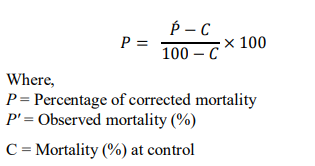
Direct
toxicity tests: Toxicity
tests were conducted according to the Film residue method describe by
Busvine (1971). One mL solution of each leaf, bark, and stem extracts
of eucalyptus was applied to the petridish (60 mm dia.). The
petridishes were then kept in the air for drying for a few minutes.
The solvent was fully evaporated and 3 days old 10 adults were
released in each petridish. Three replications were made for each
treatment and each concentration including control. An equal number
of insects with only methanol solvent were treated as control. Insect
mortality was recorded every 24 hours after treatment (HAT) upto 120
HATs. The percentage of mortality was corrected using Abbott’s
(1987) formula before analysis
Residual
toxicity test: Leaf,
bark, and stem extracts of four different concentrations were mixed
with wheat grain separately (1 mL/25 g wheat) followed by air-dried
about 10 minutes. Five pairs of 3 days old beetles were released into
the pot containing treated with leaf, bark and stem extracts and the
pot was covered with a perforated lid. In control treatments, only
methanol solvent was used. Three replications were maintained for
each of the concentrations of the individual leaf, bark and stem
extracts along with control. All pots were kept at ambient
temperature (27±3°C) in the laboratory for oviposition.
After 7 days, dead and alive beetles were removed from each
container. When adults were emerged, the number of adult emergence
was counted after every 7 days interval upto 42 days. Percent
inhibition rate (%IR) was calculated by the following formula
(Talukder and Howse 1993):

Repellency
test: The repellent activities were evaluated using
the filter paper impregnation method (Talukder and Howse
1994). Firstly, the Whatman no. 1 filter paper was cut
into two halves and 1 mL solution of each concentration was applied
to one half uniformly. Only the solvent was used in the control half
of the filter paper. The treated half and control half was then
air-dried. Three days old 10 insects were released at the centre of
each petridish (90 mm diameter) and a cover was placed on the
petridish. Three replications were used for each extract and each
concentration. The number of insects on each portion was counted at
hourly intervals upto the 5th hour
with control treatment. The data was expressed as % of repulsion
(%PR) using the following formula:

Positive
values expressed repellency and negative values attractancy. The
average values were categorized as describe by McDonald et al.
(1970). The average values were categorized as class 0: repellency
0>0.01 to 0.1%, class I: repellency 0.1 to 20.0%, class II:
repellency 20.1 to 40.0%, class III: repellency 40.1 to 60.0%, class
IV: repellency 60.1 to 80.0% and class V: repellency 80.1 to 100.0%,
respectively.
Statistical
analysis: The
collected data were statistically analyzed by a completely randomized
design (CRD) with the help of MSTAT-C statistical program. The mean
values were adjusted by Duncan’s New Multiple Range Test
(DMRT). The insect
mortality
data were also analyzed by probit analysis program. All graphical
works were done with Microsoft Excel program.
RESULTS
AND DISCUSSION
Mortality
effect of eucalyptus plant extracts against rice weevil: The
results of the direct toxic effects of leaf, bark and stem extracts
of the eucalyptus plant, doses and their interactions at different
time intervals against the adult of rice weevil are presented in
Table 1 and 2. The toxicity effect of leaf, bark and stem showed
different level of toxicity against the adult of rice weevil and
toxicity was differed significantly (P>0.05) among the treatments.
The average mortality percentage of rice weevil at 24, 48, 72, 96 and
120 hours after treatment (HAT) indicated that stem extract possessed
the highest (mortality34.53%) toxic effect, whereas leaf extract
possessed the lowest (mortality, 11.20%) toxic effect (Table 1).
Mortality percentages were increased proportionally with the
increased time intervals. The order of toxicity of different parts of
eucalyptus plant extracts against rice weevil were stem>bark>leaf.
Mortality of rice weevil also differed significantly among all the
concentrations level at different time interval (Table 1). The
highest average mortality (27.17%) was observed at the highest
concentration (2.0%) of plant extract and the lowest average
mortality (12.33%) was found at the lowest concentration (0.5%). No
mortality was recorded in untreated control up to 120 HAT. The
average mortality percentage of concentration directly proportional
to the level of concentration of eucalyptus plant extracts. The
interaction effects of different parts, doses and time is presented
in Table 2. The highest average mortality (60.67%) of rice weevil was
found from the extracts of stem at 2.0% and lowest (8.00%) from the
extracts of the leaf at 0.5% concentration level. No adult mortality
was found at control treatments in the interaction of doses and time
at 24, 48, 72, 96 and 120 HATs.
It
was observed from the above findings that the eucalyptus plant
extracts were effective for controlling the rice weevil but stem
extract was the most effective. The present study agreed with the
previous finding of Sarac and Tunc (1995), Aggarwal et al. (2001) and
Lee et al. (2004a and b). Sarac and Tunc (1995) observed that oil
ofPimpinella
anisum caused 95%
mortality of Tribolium
confusum, and S.
oryzae within
shorter exposure. Oils of Tuymbra
spicata var. spicata, Eucalyptus camaldulensis and Satureja
thymbra showed
higher toxicity only to S.
oryzae.Aggarwalet al.
(2001) observed that the
lethal dose and lethal concentration required to kill 50% of the
beetles (LD50 and
LC50,
respectively) varied with the toxicity assay method. LD50 values
of 0.03, 0.04, and 0.04 ml/insect against C.
maculatus, R.
dominica and S.
oryzae, respectively,
were found in the topical application assay, while the LC50 values
in the fumigant assay were 0.28, 0.33, and 0.46 ml/l against C.
maculatus, R.
dominica, and S.
oryzae, respectively.
In the study of Lee et al. (2004b) considered that 6 out of 42
essential oils extracted from species of the family Myrtaceae found
in Australia were shown to have potent fumigant toxicity against
three major stored grain insects: S.
oryzae, T.
castaneum and R.
Dominica. They
indicated fumigant effects of the essential oils rich in 1,8-cineole
were considered to warrant further research into their potential for
commercial use.
Table
1. Direct toxic
effect of eucalyptus plant extWithin column values followed by
different letter(s) are significantly different by DMRT at 5 % level
of probability.
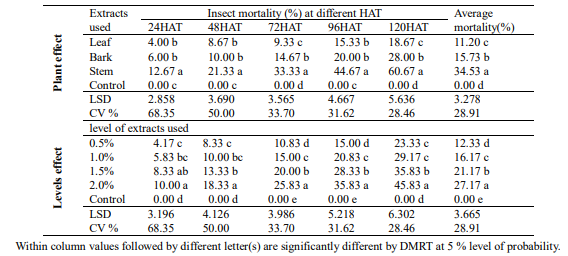
Table
2. Direct toxic
effect of eucalyptus plant extracts of different doses against rice
weevil at different HAT (Interaction of plant, dose and time)
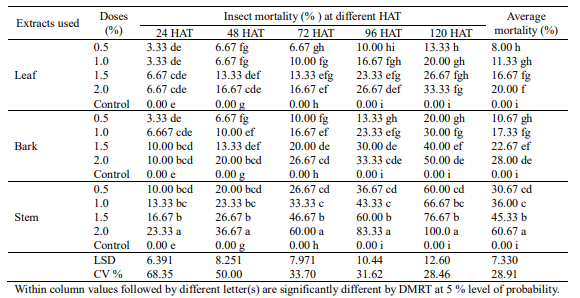
Probit
analysis for mortality effects of eucalyptus plant extracts against
rice weevil: The
results of the probit analysis for the estimation of LD50 values,
chi-square values and their 95% fiducial limits at 24, 48, 72, 96 and
120 HAT for the mortality of rice weevil are presented in Table 3.
The LD50 values
of the leaf (138.643 %), bark (32.626 %) and stem (15.033 %) at 24
HAT indicated that stem extract was the most toxic followed by bark
and leaf extract. Stem extract was also maintained its highest
toxicity, when the LD50 values
were compared at 48 HAT (7.618%), 72 HAT (1.609 %), 96 HAT (0.914 %)
and 120 HAT (0.435 %) and almost a similar trend of results was
observed where lower LD50 values
at 48, 72, 96 and 120 HAT in stem extracts. The results indicated
that the eucalyptus plant extracts were toxic to rice weevil and the
order of toxicity levels were found as stem> bark> leaf. The
chi-square values of eucalyptus plant extracts at different HAT were
insignificant at a 5% level of probability and did not show any
heterogeneity of the mortality data.
The
lower LD50 values of stem extract
indicated that the highest toxic effects against rice weevil. The
present study agreed with the previous findings of Aggarwal et
al. (2001). They observed that the lethal dose and lethal
concentration required to kill 50% of the beetles (LD50 and
LC50, respectively) varied with the toxicity assay method.
LD50 values of 0.03, 0.04, and 0.04 mL/insect
against C. maculatus, R. dominica and S.
oryzae, respectively, were found in the topical application
assay, while the LC50 values in the fumigant assay
were 0.28, 0.33, and 0.46 ml/l against C. maculatus, R.
dominica, and S. oryzae, respectively.
Table
3. Probit analysis of eucalyptus plant extracts (leaf, bark
and stem) against rice weevil after 24, 48, 72, 96 and 120 HATs

Probit
regression lines for mortality effect of eucalyptus plant extracts
rice weevil: The
probit regression lines for the effect of leaf, bark and stem
extracts of eucalyptus plant against rice weevil, Sitophilusoryzae L.
at 24, 48, 72, 96 and 120 HATs are shown in Figure 1. The rate of
mortality of rice weevil showed positive correlations with the doses
in all cases.
The
calculated probit regression equation lines for the effects of leaf,
bark and stem extracts on rice weevil at 24 HAT were Y=0.859X +
3.077, Y= 1.055X + 2.418 and Y= 0.761X + 2.525 for stem, bark and
leaf extracts respectively (Figure 1). Comparing among three lines,
the regression line for stem extract showed the highest probit
mortality and leaf extract showed the lowest probit mortality. The
probit regression equations at 48 HAT were Y=0.768X + 3.568, Y=0.987X
+ 2.786 and Y=0.892X + 2.808 for stem, bark and leaf extracts,
respectively. Comparing among these three lines, the regression line
for stem extract showed the highest mortality effect whereas leaf
extract showed the lowest mortality effect.
The
calculated regression equations for the effects of eucalyptus plant
extracts on rice weevil at 72, 96 and 120 HAT were Y=1.386X + 3.332,
Y=1.055X + 2.978 and Y=0.849X + 2.903; Y=1.951X + 3.135, Y=1.177X +
3.063 and 1.119X + 2.935; Y=2.324X + 3.401, Y=1.367X + 3.169 and
Y=1.140X + 3.054 for stem, bark and leaf extracts, respectively. The
regression line for stem extract showed the highest mortality effect
and the leaf extract showed the lowest mortality effect.
The
probit regression lines for the effects of different parts of
eucalyptus plant extracts against rice weevil showed a clear
relationship between probit mortality and their doses and the probit
regression lines become steeper as doses increased because the adult
insects were treated with more toxins for the same period at higher
doses. Comparing among these three lines, the highest probit
mortality was found with stem extract at 24, 48, 72, 96 and 120 HATs.
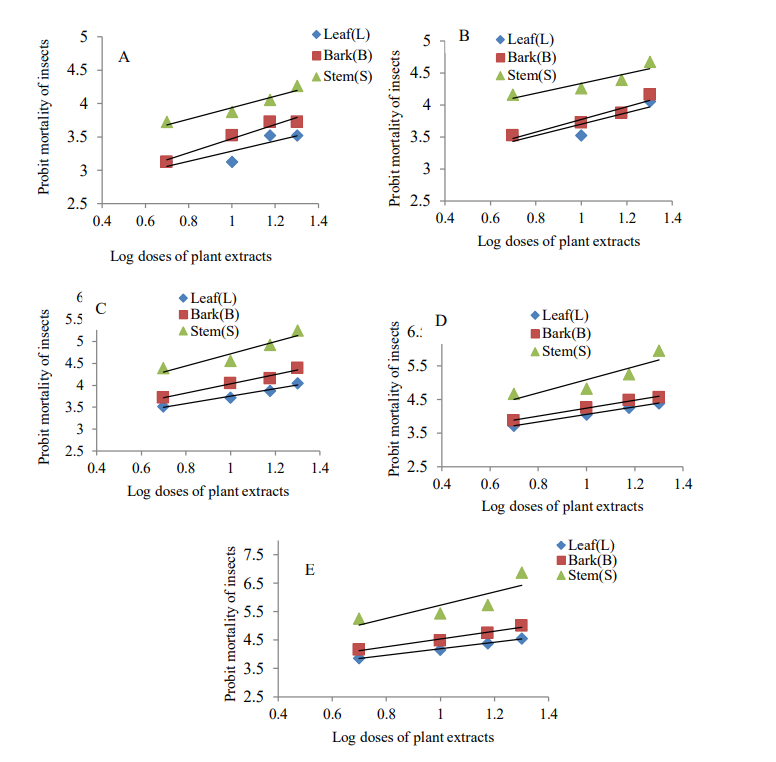
Figure
1. Relationship between probit mortality and log doses of
eucalyptus plant extracts on rice weevilat24 (A), 48 (B), 72 (C), 96
(D) and 120 (E) HATs
Residual
effect of eucalyptus plant extracts against rice weevil: The
efficacy of leaf, bark and stem extracts of eucalyptus plant as
protectants for wheat grains were evaluated and are shown in Table 4
and 5. The average numbers of adult emergence were statistically
different among the plant extracts (Table 4). The highest number of
adult emergence was recorded in control (78.33). The lowest average
numbers of adult emergence in stem (36.53) while the highest from
leaf (39.56) extracts. The highest infestation inhibition was found
in stem (67.42%). The lowest infestation inhibition was found in leaf
(62.47%) followed by bark (64.42%) which was statistically different
(Table 4). The number of adult emergence was found the highest
(43.39) and the infestation inhibition was found the lowest (59.71%)
at the dose level of 0.5% whereas the lowest number of adult
emergence was found (38.39) at the dose level of 2.0% and the
infestation inhibition rate was found the highest (66.33%) at the
dose level of 2.0%. The interaction of plant extracts, doses at
different HAT shown in Table 5. The lowest adult emergence was found
on 2.0% dose of stem extract (22.00) where the highest infestation
inhibition was found 72.87% while the highest adult emergence was
found at 0.5%dose of leaf extract (33.56) and the lowest inhibition
was found 57.30% followed by bark extract at the dose level of 0.5%
adult emergence (31.55) and inhibition was found at 59.94% which was
statistically different. The average adult emergence and the
percentage of infestation inhibition were statistically significant
different from the eucalyptus plant extracts at all levels of
concentration. The results indicated that the residual effects of
different plant materials decreased gradually with the increase of
time interval.From the above results, it was clear that the stem
extract was the most effective for controlling the rice weevil. The
present finding also agreed with that of Mani et al. (1993).
They observed that the adult females of Corcyra
cephalonica exposed to the volatile leaves of tulsi (Ocimum
basilicum) and eucalyptus (E.rostrata) laid
reduced the number of eggs. El-Atta and Ahmed (2002) established that
leaf powder, seed kernel powder and oil extracted from the seeds
of A. indica and leaf powder and oil extracted from
the leaves of E. canialdulensis and benzene
hexachloride (BHC) were tested at 1, 3 and 5% (w/w or v/w) against S.
oryzae. Neem oil (NO) and eucalyptus leaf oil (ELO) at 3 and 5%
were as efficient as BHC and significantly (P<0.001) reduced egg
laying by S. oryzae, whereas eucalyptus leaf powder
(ELP) had no significant effect.
Table
4. Residual
toxicity effect of eucalyptus plant extracts and different doses of
plant extractstreated against rice weevil
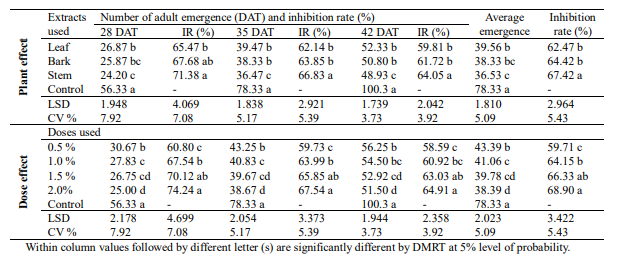
Repellency
effect of eucalyptus plant extracts against rice weevil: The
repellency effects of eucalyptus plant extracts against rice weevil
showed that leaf, bark and stem extracts has strong repellent action
(Table 6). Among the different parts of eucalyptus plant extracts
tested, stem extracts showed the highest mean repellent effect
(73.33%) followed by bark (63.00%) whereas leaf extracts showed the
lowest mean repellent (56.33%) effect. On the basis of repellency
rate, it was found that stem and bark extracts were in the same
repellency class i.e. Class IV and leaf extracts werein Class III.The
mean repellent (%) effect of eucalyptus plant extracts in different
dose levels on rice weevil is also presented in Table 6. The
repellency rate did not increase uniformly with the doses. The
highest mean repellency effect was found with 2.0% dose extract
(75.56%) and the lowest was found with 0.5% dose extract (52.89%).
The results also indicated that repellency action increased
proportionally to the concentration. The interaction repellent effect
of eucalyptus plant extract and their doses against rice weevil at
different HATs is presented in Table 7. The repellent effect
influenced by different levels of doses at different HAT and had
significant differences. The highest mean repellency effect was found
on a 2.0% dose of stem extract (82.67%) whereas the lowest mean
repellency effect was found on 0.5% dose of leaf extract (42.67%).
Table
5. Combined residual toxicity effect of plant and doses at
different time treated against rice weevil
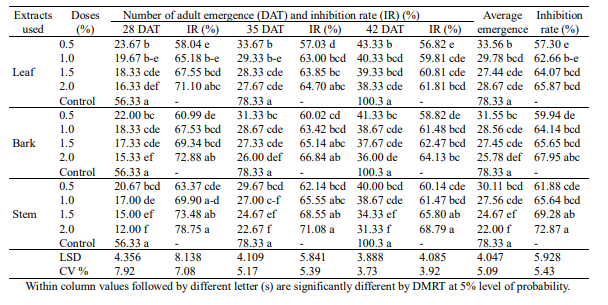
Table
6. Repellent
effect of eucalyptus plant extracts and doses against Sitophilus
oryzae L. using
treated and untreated filter paper at different HAT (Interaction of
plant extracts and doses)
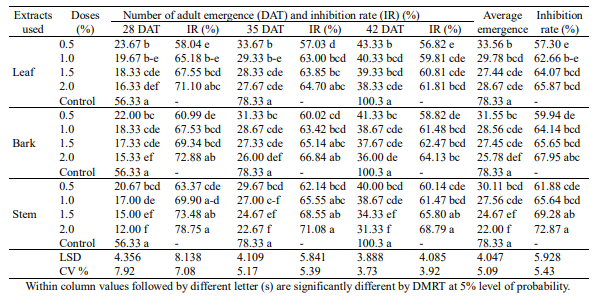
From
the above results, it was found that the eucalyptus plant extracts
were effective for controlling the rice weevil but stem extract was
the most effective. The present study agreed with the previous
finding of Sharaby (1988) in where they reported that eucalyptus
leaves showed more repellent action on S.
oryzae. Khan and
Shahjahan (1998) indicated that dried powder of Eucalyptus
teretocornis leaves
was extracted with hexane, acetone, ethanol and methanol and the
extracts were tested to observe their effects against adults
of Sitophius
oryzae and C.
chinensis. The results
also stated that the percentages of repulsion for S.
oryzae were 71.1,
74.7, 69.0 and 63.3% respectively. Lee et al. (2004a) showed that
different solvent extracts of eucalyptus leaf have repellent property
against adults of S.
oryzae. Mishra et al.
(2012) indicated that the repellency of E.
globulus and O.
basilicum was
9.16±0.30 and 8.50±0.22 for T.
castaneum and
8.66±0.33 and 8.16±0.30 for S.
oryzae.
Table
7. Repellent effect of
eucalyptus plant extracts at different dose level against Sitophilus
oryzae L. using
treated and untreated filter paper at different HAT (Interaction of
plant extracts, dose and time)

The
eucalyptus plant extracts of leaf, bark and stem were used as a
botanical pesticide against stored grain pest, rice
weevil, Sitophilus
oryzae L. Farmer
cannot always afford to buy synthetic pesticides to protect stored
grain and products. The highest direct toxic effects were recorded in
stem extract treated insect which indicated higher toxicity of stem
extract for controlling rice weevil, Sitophilus
oryzae L. From
the present finding, it conclude that the eucalyptus plant of leaf,
bark and stem extracts are effective in reducing the number of adult
emergence and increasing infestation inhibition rates and farmers
might apply for protecting their stored grain against rice weevil.
REFERENCES
Abbott
WS. 1987. A method of computing the effectiveness of an insecticide.
Journal of the American Mosquito Control Association. 3: 302-303.
Adedire
CO, Obembe OO, Akinkurolele RO andOduleye O. 2011. Response
of Callosobruchus
maculatus (Coleoptera:
Chysomelidae: Bruchinae) to extracts of cashew kernels. Journal of
Plant Diseases and Protection. 118
(2): 75-79.
Aggarwal
KK, Tripathi AK, Prajapati V and Kumar S. 2001.Toxicity of 1,
8-Cineole towards three species of stored product Coleopterans.
Insect Science and its Application. 21(2): 155-160.
Ali
A, Ahmad F, Biondi A, Wang Y and Desneux N. 2012. Potential for
using Daturaalba leaf
extracts against two major stored grain pests, the khapra
beetle,Trogoderma
granarium and the
rice weevil,Sitophillus
oryzae. Journal of
Pest Science. 85(3): 359-366.
Arya
M and Tiwari R. 2013.Efficacy of some indigenous bioproducts against
rice weevil, Sitophilus
oryzae (Linn.) on
wheat. Indian Journal of Applied Research. 3(6): 2249.
Bachchu
MAA, Ghani MO, Hossain MA and Ara R. 2013. Insecticidal and repellent
effect of some indigenous plant extracts against rice weevil,
Sitophilus oryzae (L.)
(Coleoptera: Curculionidae). Bangladesh Journal of Entomology. 23(2):
97-114.
Batish
DR, Singh HP, Kohli RK and Kaur S. 2008. Eucalyptus essential oil as
a natural pesticide. Forest Ecological Management. 256: 2166–2174.
Busvine,
JR. 1971. A critical review of the techniques for testing
insecticides.Commonwealth Agricultural Bureau, London. p. 345.
Cosimi
S, Rossi E, Cioni PL and Canale A. 2009. Bioactivity and qualitative
analysis of some essential oils from Mediterranean plants against
stored-product pests: evaluation of repellency against Sitophilus
zeamais Motschulsky, Cryptolestes
ferrugineus (Stephens)
and Tenebrio
molitor (L.).
Journal of Stored Products Research. 45(2): 125–132.
El-Atta
HA and Ahmed A. 2002.Comparative effects of some botanicals for the
control of the seed weevil Caryedons
erratus Olivier
(Col. Bruchidae). Journal of Applied Entomology. 126(10): 577-582.
Ghani
MO, Bachchu MAA, Hossain MA and Ara R. 2014. Bioefficacy of some
indigenous plant extracts against rice weevil, Sitophilus
oryzae (L.).
Journal of Science and Technology. 12: 26-34.
Hanies
CP. 1991. Insects and Arachnids of Tropical Stored Products; Their
Biology and Identification.2nd Edition. Natural Research Institute.
pp. 23-47.
Haque
MA, Nakakita H, Ikenaga H and Sota N. 2000. Development inhibiting
activity of some tropical plants against Sitophilus
zeamais Motschulsky
(Coleoptera: Curculionidae). Journal of Stored Product Research. 36:
281 – 286.
Ileke
KD and Olotuah OF. 2012. Bioactivity of Anacardium
occidentals and Allium
sativum powders
and oils extracts against cowpea bruchid, Callosobruchus
maculatus (F.)
(Coleoptera: Chrysomelidae). International Journal of Biology. 4 (1):
96-103.
Khan
M and Shahjahan RM. 1998. Evaluation of eucalyptus leaf extracts as
repellent for adult of Sitophilus
oryzae(L.) and
attractant for Callosobruchus
chinensis (L.).
Bangladesh Journal of Entomology. 8(1 and 2): 81-88.
Lee
BH, Annis PC, Tumaalii F and Lee SE. 2004a. Fumigant toxicity
of Eucalyptus
blakelyi and Melaleuca
fulgens essential
oils and 1, 8-cineole against different development stages of the
rice weevil Sitophilus
oryzae(L.).
Phytoparasitica. 32: 498–506.
Lee
BH, Annis PC, Tumaalii F and Choi WC.2004b. Fumigant toxicity of
essential oils from the Myrtaceae family and 1,8-cineole against 3
major stored-grain insects. Journal of Stored Products Research. 40:
553-564.
Mani
HC, Pathak PH and Krishna SS. 1993. Effect of certain volatile
chemicals and other factors on the reproductive biology of Corcyra
cephalonica. Annals of
Entomology. 11(2): 59-65.
Mcdonald
LL, Guy RH and Speirs RD. 1970. Preliminary evaluation of new
candidate materials as toxicants repellents and attractants against
stored product insects. Marketing Research Report. Number 882.
Washington.
Mishra
BB, Tripathi SP and Tripathi CPM. 2012. Repellent effect of leaves
essential oils from Eucalyptus
globulusv (Myrtaceae)
and Ocimum
basilicum (Lamiaceae)
against two major stored grain insect pests of Coleopterons. Journal
of Nature and Science. 10(2): 50-54.
Rajendran
S and Sriranjini V. 2008. Plant products as fumigants for
stored-product insect control. Journal of Stored Products Research.
44(2): 126–135.
Rees
D. 2004. Insects of stored products.CSIRO, Collinwood, Australia.
pp. 190.
Sarac
A and Tunc I. 1995. Toxicity of essential oil vapours to stored
product insects. Zeitschrift fur Pflanzenkrankleiten and
Pflan-Zenschhutz. 102(1): 69-74.
Sharaby
A. 1988. Evaluation of some Myrtaceae plant leaves as protectants
against the infestation by Sitophilus
oryzae (L.)
and Sitophilus
granarius (L.).
Insect Science and its Application. 9: 465-468.
Talukder
FA and Howse PE. 1994. Laboratory evaluation of toxic and repellent
properties of the pithraj tree, Aphanamixis polystachya wall
and parker against Sitophilus oryzae L.
.International Journal of Pest Management. 41(3): 274 – 279.
Talukder
FA and Howse PF. 1993. Deterrent and insecticidal effects of extracts
of pithraj, Aphanamixi
spolystachya (Meliaceae),
against Tribolium
castaneum in
storage. Journal of Chemical Ecology. 19: 2463-2471.










